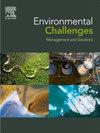Machine learning-based spatio-temporal assessment of land use/land cover change in Barishal district of Bangladesh between 1988 and 2024
Q2 Environmental Science
引用次数: 0
Abstract
Barishal, known as the “Land of Paddy, Rivers, and Canals,” bears immense historical, social, and economic importance as a major agricultural, cultural, and financial hub of Bangladesh. However, the absence of a comprehensive LULC inventory, high landscape variability, and the limited availability of high quality remotely sensed data make the quantification of LULC changes in the region extremely challenging. This study is the first of its kind in Bangladesh to propose a cloud-based, open-source, machine learning framework that integrates spectral, textural, and topographic information to assess the spatio-temporal dynamics of LULC change in Barishal over 35 years. The performance of four machine learning algorithms (Support Vector Machine, Classification and Regression Tree, K-Nearest Neighbor, and Random Forests) were evaluated to ensure classification reliability. Results indicate that Random Forest outperforms other classifiers, achieving an average accuracy of 99 % across all study periods, making it the most suitable model for classifying heterogeneous landscapes. An analysis of multi-temporal LULC maps reveals a net increase in wetland (0.35 %), built-up (1.81 %), vegetation (8.48 %), and a net decrease in agriculture (−10.33 %) and bare soil (−0.36 %), primarily due to indiscriminate land use transitions. The study establishes a comprehensive and reliable baseline for Barishal’s LULC and introduces a rapid, open data driven approach for mapping complex, heterogeneous coastal landscapes globally. The spatio-temporal patterns of LULC underscore the urgent need for climate-resilient planning in Barishal and provide valuable insights for evidence-based policymaking necessary in implementing SDG 11: Sustainable Cities and Communities and SDG 15: Life on Land.

基于机器学习的1988 - 2024年孟加拉国Barishal地区土地利用/土地覆盖变化时空评价
巴里沙尔被称为“稻田、河流和运河之乡”,作为孟加拉国主要的农业、文化和金融中心,具有巨大的历史、社会和经济重要性。然而,缺乏全面的LULC清单、高景观变异性以及高质量遥感数据的有限可用性使得该地区LULC变化的量化极具挑战性。这项研究是孟加拉国首次提出基于云的开源机器学习框架,该框架集成了光谱、纹理和地形信息,以评估Barishal 35年来LULC变化的时空动态。评估了四种机器学习算法(支持向量机、分类与回归树、k近邻和随机森林)的性能,以确保分类可靠性。结果表明,随机森林分类器优于其他分类器,在所有研究期间平均准确率达到99%,是最适合异质景观分类的模型。对时序LULC地图的分析显示,湿地(0.35%)、建筑(1.81%)、植被(8.48%)净增加,农业(- 10.33%)和裸地(- 0.36%)净减少,主要是由于不加区分的土地利用转变。该研究为Barishal的LULC建立了全面可靠的基线,并引入了一种快速、开放的数据驱动方法,用于绘制全球复杂、异质的沿海景观。LULC的时空格局凸显了巴里沙尔对气候适应型规划的迫切需求,并为落实可持续发展目标11:可持续城市和社区以及可持续发展目标15:陆地生命所需的循证政策制定提供了宝贵见解。
本文章由计算机程序翻译,如有差异,请以英文原文为准。
求助全文
约1分钟内获得全文
求助全文
来源期刊

Environmental Challenges
Environmental Science-Environmental Engineering
CiteScore
8.00
自引率
0.00%
发文量
249
审稿时长
8 weeks
 求助内容:
求助内容: 应助结果提醒方式:
应助结果提醒方式:


